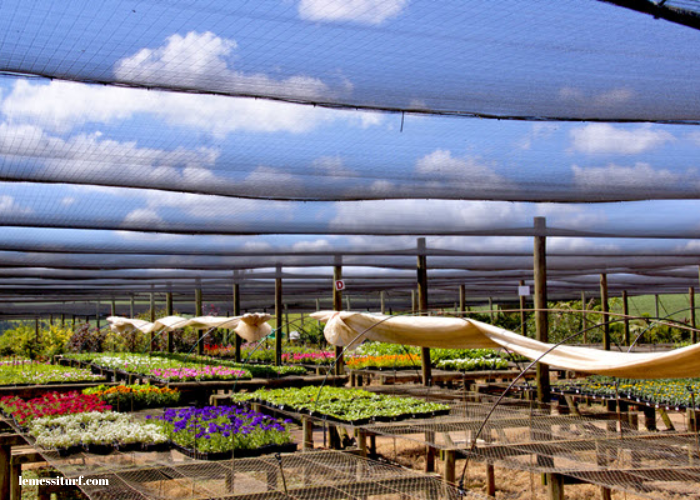Woven shade cloths are made by interlacing warp monofilament threads and weft tape yarns. The specialized weaving technology makes them more rigid, and the structure offers better stability than knitted shade cloth. Woven shade fabric also has a higher durability and a longer lifespan than knitted shade cloth. It is highly customizable and can be installed in a wide range of structures.
UV Resistance
The knitted design and UV stabilized polyethylene of shade cloth reduces heat build up while protecting plants from harmful sunlight and UV rays. This material also helps minimize soil moisture loss through evaporation.
Woven shade cloth is woven using one or multiple warp threads and weft tapes that create horizontal and vertical grid lines. It is a popular choice for safeguarding crops against harmful UV rays, heat, and pests. Woven shade cloth is typically 20-25% heavier than Knitted Shade Cloth and has more color options. It is less breathable than Knitted Shade Cloth, but is extremely durable and can resist rips, tears, fraying, and unraveling.
Air Permeability
Knitted shade cloth is a great option for areas where livestock roam throughout the day because it provides them with protection from UV light and heat. This fabric can also withstand heavier traffic than other types of netting, and its thickness makes it resistant to tearing if it gets snagged by equipment or animals.
The knitted shade cloth we carry at QiBang Netting is a strong lock-stitch material that resists tears and fraying and allows airflow. It’s the ideal choice for covering your greenhouse or shading other outdoor spaces. Its durability and versatility make it a good option for agricultural, commercial, and residential use.
Shrinkage
Depending on the manufacturing process, knitted shade cloth and woven shade cloth differ in terms of strength and resilience. Woven shade cloth typically uses a mono+mono or tape+mono thread configuration, while knitted shade cloth relies on a raschel knitting pattern and utilizes a combination of both mono-filament and tape filaments. This unique construction helps the fabric resist tearing, fraying, and unraveling. It also allows for flexibility and the ability to conform to uneven or curved structures. This makes it a more forgiving material during the installation process, accommodating slight measurement errors or bending during handling. It is also less likely to shrink when subjected to moisture or harsh environmental conditions.
Applications
Woven and knitted shade cloth are popular choices for shade structures in gardens and greenhouses. They both offer a variety of benefits and drawbacks that vary based on their specific applications, climatic conditions, and installation processes. Woven shade cloth utilizes warp monofilament yarns and weft tape yarns to create a highly durable fabric that’s well-suited for long-term agricultural use. Its durability and high shading rate make it an ideal choice for protecting crops against the damaging effects of summer heat stress.
Knitted shade cloth, on the other hand, uses a raschel knitting process to interlock loops of thread, resulting in a flexible, stretchy fabric that can adapt to irregular or curved surfaces. Its flexibility and breathable structure also make it ideal for cooling your greenhouse or garden.
Lifespan
The lifespan of shade cloth is greatly impacted by how it’s treated. It’s important to avoid techniques that may shorten the fabric’s life, such as power washing or abrasive scrubbers. Instead, use a mild soap and lukewarm water mixture to wash the material.
The right shade cloth helps plants thrive in extremely hot summer conditions by reflecting sunlight and reducing heat buildup. Understanding the differences between knitted and woven shade cloth, including their UV resistance, shading effect, air permeability, shrinkage, applications and lifespan, will help you make an informed choice that aligns with your greenhouse needs. You’ll also need to consider the ease and method of installation, as well as support accessories like shade cloth grommets.
Installation
For maximum privacy, indoor vertically hung Black 70% knit shade cloth provides the best solution. From the inside, you can still see out but from a distance, it’s nearly impossible to make out any shape or shadow on the other side. Choose a frame that will provide structural stability. Wood is a popular choice and offers a natural look, while metal, like aluminum or steel, can be more durable. The shade cloth can be attached to the frame using wiggle wire, shade cloth clips or by attaching it with a rope and zip ties. It can also be anchored to the ground with grommet fittings.
Conclusion
Adding shade cloth to your greenhouse or garden will reduce your summer cooling costs. Choosing the right shade cloth depends on your specific needs and environmental conditions. Woven and knitted shade cloths each have distinct advantages and disadvantages, which can impact your selection and installation processes. The main difference is the structure of the fabric.
